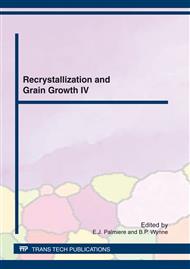p.732
p.737
p.738
p.739
p.745
p.751
p.758
p.764
p.770
Zener Pinning Pressure in Tempered Martensite Lath Structure
Abstract:
The Zener drag force exerted by M23C6 carbides, Fe2(W,Mo) Laves phase and M(C,N) particles for migration of different grain boundaries in P92-type and P911+3%Co heat-resistant steels was calculated. In particular, the prior austenite grain boundaries (PAGB), boundaries of packets and blocks, which are mainly high-angle boundaries (HAGB), were addressed. Zener pinning pressures were determined for each type of dispersoids separately taking into account that the M23C6 carbides, Fe2(W,Mo) Laves phase are inhomogeneously distributed such that they are mainly located at the boundaries, and the M(C,N) dispersoids are uniformly distributed throughout the metallic matrix. In the both steels, the pinning pressure from the second phase particles located at grain boundaries is about an order of magnitude higher than that caused by homogeneously distributed MX precipitates. In spite of numerous second phase particles precipitated during tempering, grain growth (although rather moderate) occurred during the creep tests of the studied materials. The driving pressure for grain boundary motion might be mostly associated with high dislocation density retained in the tempered martensite structure. The resulting pressure for grain growth in the P92-type steel under creep conditions at 600 and 650°C is somewhat higher than that for the P911 steel.
Info:
Periodical:
Pages:
745-750
Citation:
Online since:
April 2012
Price:
Сopyright:
© 2012 Trans Tech Publications Ltd. All Rights Reserved
Share:
Citation:


